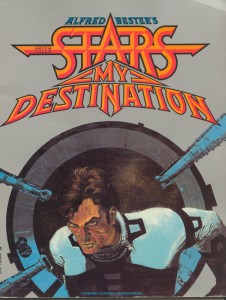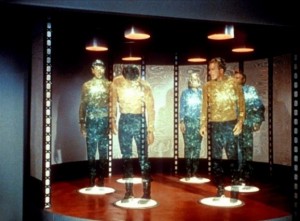
I’ve long said that if I could have any superpower, it would be teleportation. To be liberated from airports, airplanes and tickets would be amazing. I wouldn’t mind leaving behind my passport and never suffering another border crossing again, although the elimination of travel bureaucracy would be a breakthrough of a different kind. Science fiction great Alfred Bester was similarly fascinated with teleporting, or as he calls it in The Stars My Destination, “jaunting.”
Bester focuses on the implications of jaunting, namely the social and economic ones. In fact, the inner planets and the outer planets are warring because of it, even though there’s a 1,000-mile limit to each jaunte (but no limits to how many times one can jaunte so long as there’s an open landing platform and one knows from where and to where one’s jaunting). There are jaunte-proof prisons for criminals and people who want or need to be isolated or protected; other than that, people who can’t jaunte are both unemployable and outcasts. Bester’s portrayal of worlds where inhabitants can jaunte isn’t particularly appealing, but I’m not deterred—teleportation is still my superpower of choice. Recently, there have been three recent scientific breakthroughs suggesting that teleportation might not be limited to the Starship Enterprise.

Researchers from Scotland’s University of St. Andrews and the Czech Republic’s Institute of Scientific Instruments built a miniature tractor beam that can draw objects in by figuring out a way to create a negative force on particles. This means that the light pulls in particles, rather than pushing them away, which is what usually happens with light and solid matter collide. Their methodology entails creating an optical field that reverses light’s radiation pressure. This tractor beam only works on a microscopic level, but jaunting has to start somewhere.
Scientists have also recently created a tractor beam made from water. Professors from the Australian National University have been playing with wave generators recently, and not just so they can surf in a swimming pool, or even generate electricity. What they realized is that while it might seem that wave generators would push all floating objects in the same direction as the waves, that’s not necessarily the case. Wave generators can actually move objects in the opposite direction as the waves.
The scientists discovered that this won’t just work for any waves–the secret is the height and frequency of the waves. By floating ping pong balls on the water and toying with the waves, they figured out how to generate this effect. It’s not the waves themselves that move the objects; rather, the surface currents generated by the waves moves objects in the opposite direction (or keeps them stationary, if desired). The waves create flow patterns on the surface, including “inward flows, outward flows, or vortices….The tractor beam is just one of the patterns.” This technology probably won’t be too helpful in outer space, but in the water it could be used to achieve rescues or clean up oil spills.
Scientists at the Netherlands’ Delft Institute of Technology have figured out how to teleport data—and not by run-of-the-mill teleportation, but by quantum teleportation. This method proves the concept of quantum entanglement (even Einstein was an entanglement skeptic). Quantum entanglement is the theory that even when particles are divided, they remain linked to the extent that even when they’re separated, what happens to one affects the other—or as Einstein puts it, “spooky action at a distance.”
Spooky or not, there quantum links can be created between particles, and Dutch scientists have used that to achieve teleportation. The scientists entangled electrons inside super-cooled diamonds using lasers, and then they separated the diamonds by ten feet. Every time they changed the direction or rate of spin of one particle, the other followed suit. Even though they were only ten feet from each other, the technique should work no matter how far away the two are (the next step is to prove this by increasing the distance between the particles). If entangled quantum particles are used in, say, computers, we could all forget about thumb drives and transmit our information faster than the speed of light.
Quantum-teleportation makes me think of the ultimate feat accomplished by the protagonist of Bester’s book: space-jaunting. Now that would be something. But until then, I’ll keep hoping that my desired superpower is within reach. Whether I’ll be around to see it is another question, but by then, maybe we’ll have learned to time-jaunte.
